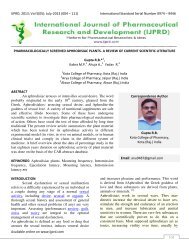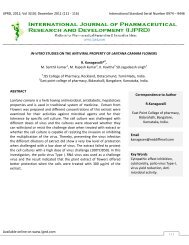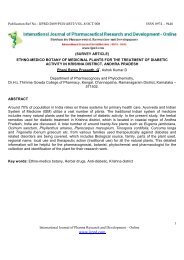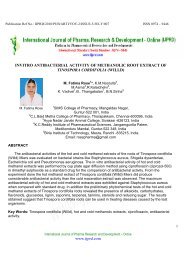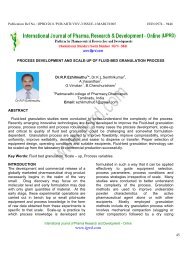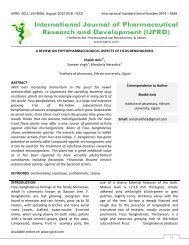Full Text - PDF - IJPRD
Full Text - PDF - IJPRD
Full Text - PDF - IJPRD
Create successful ePaper yourself
Turn your PDF publications into a flip-book with our unique Google optimized e-Paper software.
<strong>IJPRD</strong>, 2013; Vol 5(03): November-2013 (007 – 014) International Standard Serial Number 0974 – 9446<br />
--------------------------------------------------------------------------------------------------------------------------------------------------<br />
BIOCHEMICAL ANALYSIS OF LEAF PROTEIN CONCENTRATES PREPARED FROM SELECTED PLANT SPECIES OF<br />
TAMIL NADU<br />
Beulajosephin E.D. * 1 , Mungikar A.M 2<br />
1 Department of Botany, Madras Christian College, -Chennai, Tamil Nadu<br />
2 Department of Botany, Dr. Baba SahebAmbedkarMarathwada University –Aurangabad, Maharashtra<br />
ABSTRACT<br />
Protein is an indispensable constituent in human food. To sustain<br />
development of human, production of protein is a must. Attempts<br />
are being made to develop a technique to evaluate several precious<br />
sources of unconventional protein to diminish proteinCaloric<br />
malnutrition problem. These include isolation of oil seed protein,<br />
fish protein, single cell protein production of consumable protein<br />
from cellulosic waste, and Leaf protein. The leaf protein<br />
concentrate can be considered as a readily available and cheap<br />
source of protein. The paper envisaged the biochemical analysis of<br />
leaf protein concentrates of thirty plants collected from Tamilnadu<br />
India. The result indicates that nearly 80% of the plants are suitable<br />
for preparation of Leaf Protein Concentrates for human as well as<br />
animal nutrition.<br />
Correspondence to Author<br />
Beulajosephin E.D.<br />
1 Department of Botany, Madras<br />
Christian College, -Chennai, Tamil<br />
Nadu<br />
Email: bjosephin@gmail.com<br />
KEYWORDS : LPC- Leaf Protein Concentrates, Green Crop<br />
fractionation, Protein caloric malnutrition. (PCM)<br />
INTRODUCTION<br />
Green cover on the earth indicates the<br />
existence of life and presumptuous. Intake of<br />
nutritious food is an essential aspect human and<br />
animal nutrition. Because of increasing population,<br />
people are dying from hunger related causes every<br />
day and 75% of the population of the countries in<br />
Asia , Africa, central and South America receive<br />
only 60 % or even less protein than they need 1 .<br />
Thus increasing world population every year will<br />
make food more and more inaccessible to the<br />
growing population. Advances in science and have<br />
paved the way to get an astonishing achievement<br />
Available online on www.ijprd.com<br />
in the agricultural field. Because of this in India is<br />
presently one of the leading countries in the<br />
production of food, industrial development science<br />
and technology etc. But at the same time India has<br />
the misfortune of having about 75 million<br />
malnourished children below the age of five years,<br />
next to Bangladesh, and Nepal. Most of the people<br />
living on or below poverty line and suffering from<br />
protein deficiency.i.e Protein caloric<br />
malnutrition(PCM). The term “Kwashiorkor’ has<br />
been widely adapted to describe the protein<br />
malnutrition that is found in every economically<br />
underdeveloped country. It has been reported that<br />
7
International Journal of Pharmaceutical Research & Development ISSN: 0974 – 9446<br />
low protein diet affect hepatic and muscular<br />
glycogen level 2 It has been found that children up to<br />
the age of 60 months with severe PCM exhibited<br />
increased chromosomal aberrations in peripheral<br />
lymphocytes and bone marrow cells 3 These<br />
abnormalities persisted even after the had attained<br />
the normal height and weight. In addition to this<br />
serum leptin levels also lower in patients with<br />
anorexia nervosa and protein caloric malnutrition 4 .<br />
The minimum protein requirement is<br />
estimated to be approximately 0.5g/Kg of body<br />
weight in adult Human 5 In growing child the<br />
minimum requirement for optimum growth may be<br />
more than 3g/Kg of body weight. Pregnancy and<br />
lactation would increase the minimum required for<br />
nitrogen balance 6 . This increasing demand of food<br />
protein can be met by either, substantial increase<br />
in overall efficiency of farming or by searching<br />
novel or unconventional source of protein. Pirie 6<br />
(1942) explained the real potential of leaf protein<br />
(LP) and its use as human food during the II world<br />
war. For two decades after the war, several<br />
research workers took interest in LP<br />
work 7,8,9,10,11,12,13,14 . The Leaf Protein Concentrate<br />
(LPC) is protein rich product, containing 40-70%<br />
Protein the drymatter (DM) along with appreciable<br />
quantities β-Carotene(Pro-vitamin A), Vitamin E,<br />
and minerals. The LPC can be used as proteinvitamin<br />
–mineral supplement in poultry calf or<br />
even in human nutrition 15,16,17 The nutritive value of<br />
leaf protein depends on its amino acid<br />
composition. A comparison of leaf protein with the<br />
provisional pattern of the FAO reference protein<br />
(FAO 1965) shows that the LP has enough<br />
quantities of essential amino acids, though the<br />
amount of methionine is sometimes marginal. Leaf<br />
protein is therefore not nutritionally as good as the<br />
animal protein such as milk meat and egg, but it is<br />
than cereals, legumes and seed protein 18 In a six<br />
month feeding trial, LPC was found suitable as a<br />
protein supplement in pre school children 19.<br />
In India attempts were made by late B.C.<br />
Guha in 1943 to use leaf protein from water<br />
hyacinth and other species 20 The work was then<br />
initiated by Subramanyam and his colleagues 21 at<br />
CFTRI, Mysore. From 1965 onwards N. Singh and<br />
Available online on www.ijprd.com<br />
his colleagues at CFTRI explored the possibilities of<br />
using green LP in human food and attempts were<br />
made to develop an integrated technology for<br />
fodder fractionation, suitable for small scale<br />
production of LP in Indian villages. Subsequently<br />
the work on this aspect was initiated at several<br />
other places. The yields of leaf protein from<br />
Tithonia , bajra, mustard, wheat and<br />
Sesbaniareached 689,325,609,766 and 1466 kg/ha<br />
in 98,93, 71, 70 and 341 days respectively 22 About<br />
50% of protein N can be extracted from this<br />
crop 23,24 The protein N extractability of this crop<br />
was found to be similar to that of Lucerne and<br />
protein concentrate prepared from this crop,<br />
containing 51.9 % crude protein, is nutritionally<br />
superior with a value of protein efficiency ratio<br />
(PER) exceeding 2.0 25 The earlier studies shows that<br />
Lucerne is a highly productive crop with consistent<br />
performance. The crop yielded over 150 t fresh<br />
vegetation , 25 t dry matter 6t crude pretein and<br />
3.2 t extractable protein per hectare when<br />
harvested 14 to 16 times in a year 26,27,28 .<br />
MATERIALS AND METHODS<br />
Pirie (1942) advocated the exploitation of<br />
green leaves as a source of protein in human<br />
nutrition. The proteins synthesized in the leaves<br />
are nutritionally far superior than the conventional<br />
protein sources. However, as the proteins in leaf<br />
are associated with indigestible fibrous or cell wall<br />
material, the leaves are not suitable in human diet<br />
as a source of protein, though leaves of many<br />
plants are consumed as vegetable and salad mainly<br />
as source of dietary fiber, minerals and vitamins.<br />
However, the fibrous material limits consumption<br />
of green leaves as a source of protein. In order to<br />
make available, the protein in leaf for humandiet, it<br />
is necessary to separate them from<br />
fibrousmaterial. Pirie suggested a process called as<br />
‘’Green Crop Fractionation (GCF)” for this purpose.<br />
During GCF ,the fresh green foliage is<br />
macerated to rupture the cell . The macerated<br />
plant material, called as pulp, is then pressed and<br />
the juice released during pressing is then employed<br />
for the isolation of protein in it. Either heating or<br />
acidification of the juice result s into coagulation of<br />
8
International Journal of Pharmaceutical Research & Development ISSN: 0974 – 9446<br />
proteins resulting into a curd referred to as leaf<br />
protein concentrate (LPC) ,which is separated from<br />
remaining portion of the juice by filtration . The<br />
LPC is dark green in colour with 40-70% curd<br />
protein in its dry matter (DM) depending on the<br />
species from which it is extracted. Inaddition, it<br />
contains appreciable amount of minerals, lipids and<br />
vitamins. The incorporation of LPC in human<br />
nutrition as protein-vitamin-mineral rich<br />
concentrate has been proved to be useful to<br />
overcome protein deficiency.<br />
Attempts have been made during present<br />
investigation to prepare LPC from green foliage of<br />
thirty plant species of growing in Tamil Nadu. The<br />
LPC prepared using domestic appliances and the<br />
yield of LPC dry matter (LPC-DM) per Kg of foliage<br />
was recorded. The chemical composition of the LPC<br />
sample was then studied to recommend suitable<br />
species for optimum production of high quality of<br />
leaf protein concentrate (LPC).<br />
Fresh green foliage of ErythrrinaVariegata<br />
(Fabaceae), Cassia occidentalisL (Fabaceae), Cassia<br />
toraL(Fabaceae), Sesbaniagrandiflora (L) Poir. In<br />
.Lam(Fabaceae), Vignamungo (L) Hepper, Kew Bull.<br />
(Fabaceae), Phaselous Vulgaris. L(Fabaceae),<br />
PhaseloustrilobusAit (Fabaceae), Trigonellafoenumgracum<br />
L. (Fabaceae) Madicagosativa L. (<br />
Fabaceae), Cucurbita maxima duch<br />
(Cucurbitaceae), Cucumissativus L. (Cucurbitaceae),<br />
Benincasahispida (Thunb) Cogn. (Cucurbitaceae),<br />
Cocciniagrandis (L) Voight (Cucurbitaceae),<br />
Manihotesculenta. Crantz(Euphorbiaceae,)<br />
Solanumnigrum L.(Solanaceae), Solanumtrilobatum<br />
L. (Solanaceae), Centellaasiatica(L) Urban.<br />
(Apiaceae), Moringaoleifera. Lam. (Moringaceae),<br />
Eclipta alba (L) Hsaak. (Asteraceae),<br />
AdathodaVasica. Nees (Acanthaceae),<br />
TalinumportulaceifoliumForsk.<br />
Asch.(Portulaccaceae), Souropus androgynous (L)<br />
Merr. (Euphorbiaceae) were collected from the<br />
field, early in the morning. The leaves of Brassica<br />
oleraceae. Var. capitata(Brassicaceae), Brassica<br />
olearaceae. Var. botrytis<br />
(Brassiceae),Raphanussativus L. (Brassicaceae),<br />
Coriandrumsativum L. (Chenopodiaceae),<br />
spinaciaoleraceae L. (Chenopoidiaceae),<br />
Available online on www.ijprd.com<br />
AmaranthusviridisL.<br />
(Amaranthaceae),<br />
Atriplexhortensis (Chenopodiaceae), were<br />
purchased from the vegetable market.<br />
The samples of foliages collected from<br />
either field or market were immediately brought<br />
into the laboratory for fractionation, washed with<br />
to remove adhering dust and mud particles. The<br />
foliage was then minced to a fine pulp using<br />
domestic grinder or mortar and pestle. One Kg of<br />
pulp was placed on cotton cloth and manually<br />
pressed to extract the leaf juice. The amount of<br />
leaf juice obtained per Kg of foliage was then<br />
measured and a sample was taken for preparation<br />
of leaf protein concentrate (LPC).<br />
For the preparation of LPC, about 20 ml<br />
water was taken in a stainless steel container and<br />
heated to boil. To the boiling water, 100 ml of leaf<br />
juice was slowly added with stirring till the<br />
temperature reached to 95 degree C. Due to the<br />
heating of juice, proteins in it coagulated to a curd<br />
referred as leaf protein concentrate (LPC). The LPC<br />
was then separated from remaining portion of the<br />
juice called as deproteinized juice (DPJ) by filtration<br />
through cheese cloth. The LPC thus prepared was<br />
stored in vinegar(2% acetic acid ) and sealed in<br />
specimen bottles. After storage for up to two<br />
months, the LPC was suspended in water and<br />
filtrated through Whatman filter paper. It was<br />
washed several times to it free from vinegar, dried<br />
in oven till constant weight and the yield of dry LPC<br />
(LPC-DM) was determined taking into<br />
consideration weight of the dry LPC and amount of<br />
juice extracted per Kg of green foliage.<br />
The dry LPC was ground in to a fine power and<br />
stored in plastic containers for further analysis. The<br />
nitrogen (N) content was estimated by<br />
mircoKjeldahlmethod 29 and crud protein (CP)<br />
content was expressed as N×6.25 .The contents of<br />
total ash, acid soluble ash (ASA),acid insoluble ash<br />
(AIA) and calcium (Ca) were estimated following<br />
A.O.A.C (1970) 30 method . A method described by<br />
Fiske and Subba Rau (1925) 31 as described by<br />
oser 32 (1979) was followed for the estimation of<br />
phosphorus (P) a sample of dry LPC was boiled in<br />
water , filtrated and the amount of water soluble<br />
reducing sugar (WSRS)was estimation in the<br />
9
International Journal of Pharmaceutical Research & Development ISSN: 0974 – 9446<br />
filtrated using folin-Wu tubes 32 (Oser , 1979) . A<br />
method described byCrampton and Maynard<br />
determined according to knuckles et al., (1972) 34<br />
.Crude fat content was measured by extracting the<br />
(1938)<br />
33 was followed for the estimation of sample with chloroform; methanol (2;1) using<br />
cellulose. The content of β- carotene was Soxhlet extractor .<br />
Table 1. Yield and Chemical composition of Leaf Protein Concentrates (LPCs ) prepared from various Plant<br />
species from Tamil Nadu.<br />
Sr.No Plant Yield of<br />
%of dry matter (DM)<br />
LPC-DM Nitrogen Crude Total AIA ASA Ca P<br />
g/Kg (N) Protein<br />
(CP)<br />
ash<br />
1 Cassia occidentalis 16.5 6.3 39.8 5.6 0.1 5.5 0.63 0.26<br />
2 Cassia tora 22.5 8.1 50.0 5.2 2.2 2.9 0.38 0.32<br />
3 Erythrinavariegata 8.9 9.2 58.2 8.7 2.7 6.0 0.18 0.31<br />
4 Madicagosativa 24.1 7.9 49.4 9.7 1.7 8.0 0.41 0.36<br />
5 Phaseolustrilobus 21.9 6.4 40.1 5.0 3.8 1.1 0.16 0.11<br />
6 Phaseolus vulgaris 27.0 8.7 54.6 5.5 2.0 3.5 0.10 0.18<br />
7 Sesbaniagrandiflora 17.8 6.1 38.2 2.1 0.5 1.6 0.40 0.36<br />
8 Trigonellafoenium – 15.1 6.8 43.0 5.9 2.6 3.3 0.31 0.61<br />
graecum<br />
9 Vignamungo 12.3 4.5 28.7 7.1 2.3 4.8 0.32 0.18<br />
10 Manihotesculenta 20.3 7.7 48.6 5.5 2.1 3.3 0.58 0.15<br />
11 Souropus androgynous 25.4 5.0 31.7 4.4 1.9 2.5 0.30 0.23<br />
12 Solanumnigrum 18.0 8.7 54.8 4.2 1.0 3.2 0.70 0.18<br />
13 Solanumtrilobatum 18.1 5.4 33.8 5.2 1.3 3.9 0.89 0.35<br />
14 Coriandrumsativum 12.3 3.0 19.2 6.9 2.6 4.3 0.14 0.22<br />
15 Cucurbita maxima 13.7 7.7 48.4 9.8 4.9 4.9 0.14 0.17<br />
16 Benincasahispida 20.0 4.8 30.2 5.5 2.0 3.5 0.58 0.29<br />
17 Cucumissativus 14.7 7.0 43.7 7.1 3.5 3.6 0.14 0.22<br />
18 Cocciniagrandis 20.1 5.8 36.3 10.1 3.1 6.9 0.21 0.21<br />
19 Brassica<br />
16.9 5.0 31.7 3.5 1.7 1.8 0.32 0.19<br />
oleraceav.botrytis<br />
20 Brassica<br />
10.5 4.3 27.3 2.7 1.0 1.7 0.30 0.35<br />
oleraceav.capitata<br />
21 Raphanussativus 13.1 6.1 38.1 9.9 3.1 6.7 0.41 0.51<br />
22 Centellaasiatica 7.7 4.3 27.3 6.3 2.0 4.2 0.90 0.34<br />
23 Moringaolelifera 14.6 5.7 36.1 4.9 2.1 2.8 0.46 0.47<br />
24 Eclipta alba 9.1 5.5 34.3 10.0 3.1 6.9 0.60 0.13<br />
25 Adhatodavasica 14.7 7.2 45.3 11.0 2.5 8.5 0.32 0.47<br />
26 Talinnumportulacifolium 12.7 4.5 28.2 10.0 3.8 6.1 0.86 0.13<br />
27 Carthamustinctorius 10.1 5.8 36.3 4.6 1.6 2.9 0.28 0.98<br />
28 Spinaciaoleracea 11.7 6.1 38.1 9.9 3.1 6.7 0.41 0.56<br />
29 Amaranthusviridis 10.9 4.3 27.1 9.2 2.0 7.2 0.31 0.13<br />
30 Atriplexhortenis 14.2 5.7 35.9 6.9 2.3 4.5 0.37 0.25<br />
Mean 16.3 6.0 38.7 6.7 2.3 4.5 0.39 0.28<br />
Available online on www.ijprd.com<br />
10
International Journal of Pharmaceutical Research & Development ISSN: 0974 – 9446<br />
s.d. 05.0 1.5 09.5 2.5 1.3 2.2 0.22 0.18<br />
c.v. 30.0 26.1 24.6 37.7 57.9 49.7 56.6 63.8<br />
Table 1b. Yield and Chemical composition of Leaf Protein Concentrates (LPCs) prepared from various Plant<br />
species from Tamil Nadu.<br />
Sr.N Plant<br />
Water<br />
o<br />
soluble % of Drymatter (DM)<br />
Reducing<br />
Sugar(WSRS<br />
)<br />
Crud<br />
e Fat<br />
Cellulos<br />
e<br />
Starc<br />
h<br />
Total<br />
Suga<br />
r<br />
β<br />
Caroten<br />
e<br />
mg/100<br />
g DM<br />
1 Cassia occidentalis 0.45 18.4 1.04 2.16 4.0 2.6 3.1<br />
2 Cassia tora 0.17 16.0 1.54 1.80 6.4 3.8 3.9<br />
3 Erythrinavariegata 0.59 20.4 2.98 4.14 6.60 9.30 3.7<br />
4 Madicagosativa 0.12 10.0 7.0 1.35 6.2 3.42 3.4<br />
5 Phaseolustrilobus 0.18 14.4 2.62 3.42 3.6 5.88 3.3<br />
6 Phaseolus vulgaris 0.55 13.2 2.80 4.10 7.0 1.9 3.4<br />
7 Sesbaniagrandiflora 0.74 21.4 2.08 1.98 3.6 1.0 3.2<br />
8 Trigonellafoenium – 0.13 10.1 3.10 1.35 6.4 6.2 3.4<br />
graecum<br />
9 Vignamungo 0.49 13.2 1.10 3.06 7.2 2.4 3.1<br />
10 Manihotesculenta 0.80 12.0 3.10 3.96 6.8 6.06 3.1<br />
11 Souropus androgynous 0.32 23.4 8.00 2.16 5.0 3.81 3.3<br />
12 Solanumnigrum 0.34 18.8 1.76 2.88 6.0 6.0 3.3<br />
13 Solanumtrilobatum 0.34 18.1 2.0 2.40 5.8 3.37 3.2<br />
14 Coriandrumsativum 0.34 18.8 1.76 2.88 6.0 6.0 3.3<br />
15 Cucurbita maxima 0.81 12.0 3.10 3.96 6.8 6.06 3.1<br />
16 Benincasahispida 0.60 18.1 1.56 2.16 5.8 1.84 3.1<br />
17 Cucumissativus 0.90 18.4 1.10 3.89 5.9 4.14 3.9<br />
18 Cocciniagrandis 0.40 10.8 5.6 2.18 6.9 2.72 3.8<br />
19 Brassica<br />
0.13 9.0 2.48 3.60 6.1 1.40 3.7<br />
oleraceav.botrytis<br />
20 Brassica<br />
0.10 8.5 2.98 3.24 6.4 1.04 3.1<br />
oleraceav.capitata<br />
21 Raphanussativus 0.11 11.8 8.5 2.42 5.0 3.72 3.2<br />
22 Centellaasiatica 0.38 21.4 3.42 1.81 5.0 0.10 3.1<br />
23 Moringaolelifera 0.11 21.6 5.20 1.85 5.9 4.00 3.6<br />
24 Eclipta alba 0.55 21.5 3.28 1.61 4.1 3.80 3.2<br />
25 Adhatodavasica 0.80 9.0 1.7 2.52 6.4 8.41 3.2<br />
26 Talinnumportulacifoliu 0.32 12.0 3.3 3.96 6.5 3.72 3.6<br />
m<br />
27 Carthamustinctorius 0.20 11.8 1.0 2.42 5.0 7.25 3.2<br />
28 Spinaciaoleracea 0.72 11.5 2.1 2.70 6.4 3.20 3.1<br />
Gross<br />
Energ<br />
y<br />
Kcal/g<br />
DM<br />
Available online on www.ijprd.com<br />
11
International Journal of Pharmaceutical Research & Development ISSN: 0974 – 9446<br />
29 Amaranthusviridis 0.83 10.0 9.4 2.43 4.6 1.22 3.6<br />
30 Atriplexhortenis 0.22 9.0 6.0 6.30 4.2 4.33 3.2<br />
Mean 0.40 14.40 3.30 2.44 5.64 4.33 3.2<br />
s.d. 0.26 5.72 2.32 1.20 1.09 2.92 0.6<br />
c.v. 60.5 39.74 70.22 49.9 19.3 67.55 20.1<br />
The amount of total sugar and starch were<br />
determined following Sadasivam andManickam<br />
(1991) 35 . The chromic acid oxidation method<br />
described by O’ Shea and Maguire (1962) 36 was<br />
used for the estimation of gross energy (G.E) in<br />
Kcal/g dry LPC . Total phenol content was<br />
determined using Folin -Ciocalteau reagent while<br />
tannin content was measured using Folin –Denis<br />
reagent as described by O’ and Shea and Maguire<br />
(1962) 36 was used for the estimation of gross<br />
energy (G.E) in Kcal/g dry LPC . Total phenol<br />
content was determined using Folin –Ciocalteau<br />
reagent while tannin content was measured using<br />
Folin – Denis reagent as described by Sadasivam<br />
and Manickam (1991) 35 . All samples were analysed<br />
in duplicate. The date were statistically analysed<br />
following Mungikar 37 (1997, 2003).<br />
RESULTS AND DISCUSSION<br />
The Foliages of all plants were taken for the<br />
preparation of LPC and so far as possible they were<br />
harvested at a preflowering stage. Most of the<br />
foliages were green, soft and lush which did not<br />
created any problem during fractionation. The<br />
freshly prepared protein concentrates obtained<br />
were green in colour, however, they became faint<br />
when stored in vinegar for long time.<br />
Table 1a gives information on the yield and<br />
chemical composition of LPC samples prepared<br />
from 30 species under investigation. The yield of<br />
LPC fluctuated widely within the range of 7.70 g to<br />
27.07 g /Kg green foliage with Centellaasiatica<br />
andPhaselous vulgaris respectively (fig.1). On an<br />
average the plants under investigation yielded<br />
16.39±5.03 of LPC –DM per Kg green foliage. The<br />
coefficient of variation (C.V) for the yield of LPC<br />
was 30.07 %. On an average leguminous species<br />
like Cassia, Phaselous, andDolichous gave good<br />
6<br />
yields of LPC followed by those from<br />
Cucurbitaceous species.<br />
The nitrogen (N) percent of dry of dry<br />
matter (DM) in LPC ranged from 4.37 to 9.28% . On<br />
an average the leaf protein concentrates contained<br />
6.04% N with 26.14 % variation in its values in<br />
different species. When calculated on the basis of<br />
nitrogen content, the LPCs contained from 19.26 to<br />
58.00% Crude protein with an average value of<br />
38.77±9.57%. The wide variation in protein content<br />
(C.V=24.6%) may be due to the variation in protein<br />
content in the leaf itself, proportion of LPC and<br />
recovery extracted nitrogen in the juice. All these<br />
factors affect the yield of LPC 38 However on an<br />
average almost all LPC samples were with<br />
adequate quantities of protein. The plant material<br />
should be recommended for the preparation of LPC<br />
if the Yield of LPC –DM is more than 10g/Kg fresh<br />
weight and if the resulting LPC contains more than<br />
5% N on DM basis 39 Based on this assumption,<br />
nearly 25 species were found to be suitable for leaf<br />
protein extraction. An international Biological<br />
Programme(IBP) technical group suggested<br />
maximum ash content of 3%(on DM basis), if the<br />
LPC is to be used for human<br />
consumption 40 However, almost all species except<br />
sesbania and brassica showed lower values for<br />
ash content. The higher values of ash in the LPC<br />
samples recorded during present studies can be<br />
brought down to the expectation by thoroughly<br />
washing the vegetation with water and by giving<br />
acid treatment the LPC after its preparation. All<br />
LPC samples contained appreciable amounts of<br />
crude fat ranging betweentthe8.5 and 23.4% dry<br />
matter . Most of the LPC samples were with<br />
appreciable amount of β-carotene(Pro-vitamin<br />
A).The content of acid soluble ash fluctuated within<br />
the wide range of 1.60 and 9.05 % of DM indicating<br />
all LPC samples to be rich in mineral elements . All<br />
Available online on www.ijprd.com<br />
12
International Journal of Pharmaceutical Research & Development ISSN: 0974 – 9446<br />
LPC samples contained marginalamounts of<br />
calcium (Ca) while adequate quantities of<br />
phosphorus (P ).The amounts of these<br />
micronutrients varied widely with the value of C.V<br />
of 56.6% for calcium (Ca) and 62.8% for<br />
phosphorus (p). In comparisons toprotein, all LPC<br />
samples contained very little starch ranging from<br />
0.90 to 4.14% of dry matter (table 1 b) . The starch<br />
content also varied widely (C.V=49.9% ). The total<br />
sugar content fluctuated between 3.6 and 7.2% of<br />
LPC-DM with moderate variation among the LPCs<br />
(C.V=19.36%) The water soluble reducing sugar<br />
(WSRS) content in LPC ranged between 0.11 to<br />
0.90% of DM with a wide variation among various<br />
samples of LPC (C.V=60.5%).The variability in starch<br />
and reducing sugar content indicated breakdown<br />
of a part of starch during processing of the plant<br />
material for the preparation of LPC.<br />
CONCLUSION<br />
The use of LPC in human and animal<br />
nutrition has long been advocated to overcome<br />
protein deficiency and malnutrition. As the leaves<br />
are abundantly available and as it contain<br />
nutritionally superior proteins, their extraction<br />
from leaves can produce a cheap source of protein<br />
and vitamins. The use of LPC in human nutrition as<br />
a source of protein and vitamin A has been<br />
advocated by several workers. Choice of suitable<br />
plant material for its foliage to prepare LPC in an<br />
important and initial step for providing good<br />
quality of proteins supplement for human<br />
nutrition. During present investigation about 30<br />
plants were screened for leaf protein extraction ,<br />
25 were found suitable as they yielded more than<br />
10 g LPC –DM per Kg foliage and as the nitrogen (N)<br />
content in the resulting LPC was above 5% g dry<br />
matter (DM) as per the opinion of Singh (1969) 42 .<br />
Almost all species were found suitable for leaf<br />
protein extraction. On the basis of chemical<br />
composition the LPC samples were found<br />
nutritionally superior, even though they contained<br />
higher proportion of ash than desired. All LPC<br />
samples contained safer amounts of antinutritional<br />
compounds like Phenol and tannin. The<br />
overall result thus indicated wide scope for<br />
Available online on www.ijprd.com<br />
fractionation and production of LPC in Tamil Nadu,<br />
with the search of suitable green vegetation.<br />
REFERENCES<br />
1. Sharma, B. K., andKaur, H., (1997)<br />
“Environmental Chemistry”Pub. Krishna<br />
prakashanMandir, Meerut.<br />
2. Seal, R., andChakrawarty, I( 1982) J. Sci<br />
and Cul. 48(11):371<br />
3. Chopra, J.S., Dhand. U.K., and Mehta, S.,<br />
Bakshi, V., Rana, S., and Mehta, J (1986),<br />
Brain J. of neurology.”109. pp. 307<br />
4. Haluzik, M., Kabrt, J., Nedvidkova, J.,<br />
Svobodva, J., Kotlikova, E., Papezova A. H<br />
(1999) J . Nutrition 15 (11-12): 829<br />
5. Mertz,E.T.( 1967).“ Elementary<br />
Biochemistry”. Feffer and Simons Pvt. Ltd.,<br />
Bombay , pp., 224<br />
6. West , E.S., Todd, W.R., Mason, and<br />
Bruggen, J.T.V.(1970). “<strong>Text</strong> Book of<br />
Biochemistry ’’,4 th Edn .The Macmillan<br />
Company , Collier Macmillan Ltd., London.<br />
7. Pirie,N.W. (1942). Nature, Lond. 149: 251.<br />
8. Davys, M.,Evans, W .C, and Parr, W.H<br />
(1952). Biochem. J.,52:xxiii<br />
9. Carpenter K. J., Duckworth, J. and Ellinger,<br />
G.M . (1954) Proc. European Grasslandconf,<br />
Paris, pp. 243.<br />
10. Tilley , J. M. A., Barnes, M.L. and Raymond ,<br />
W.F (1954). Fm. Mechaning. 6: 487<br />
11. Anandaswamy,B. and Data, W.B.(1956).Bull.<br />
Cent. Fd. Technol. Res. Inst., (CFTRI) 5:105.<br />
12. Raymond, W.F. and Harris,C.E. (1957). J.<br />
British Grassland Society, 12:166.<br />
13. Sprenger ,J.J.I. (1958).In “KunstmatigDragen<br />
in de Lanndboulw,Stratsdrukkerif’.<br />
14. Guha, B.C.(1960). Lancet. 7126, 704.<br />
15. Chayan, I.H., Rai, N.P., Smith, R.H., Tristram,<br />
G. R., Thirkell, D. and Webb, T.(1961). J.Sci.<br />
Fd Agric.12:502<br />
16. Joshi, R.N., Savangikar, V.A.andPatunkar,<br />
B.W.(1984).Indian bot. Reptr.3:136<br />
17. Pirie ,N.W.(1978).”Leaf protein and other<br />
aspects of fodder fractionation” Cambridge<br />
University Press, London.<br />
13
International Journal of Pharmaceutical Research & Development ISSN: 0974 – 9446<br />
18. Shah,F.H. (1983). In “Leaf Protein<br />
Concentrates” (Telek,L. and Graham, H.D,<br />
Eds.) AVI publishing Co. Inc.Westport,<br />
Connecticut,pp. 760.<br />
19. Pirie,N. W(1969). Pl. Foods Human Nutr,<br />
1:237,<br />
20. Kamalanathan, G., Karuppiah, P. and<br />
Devdas, R.P.(1975). Indian. J. Nutr. Dietet,<br />
12:203.<br />
21. Guha,B.C( 1960). Lancet.7126, 704.<br />
22. Sur , B. KandSubramanayam,V.(1955).<br />
Indian. J.Med.Res.43:231<br />
23. Mungikar, A.M., Batra, U.R.,Tekale,N.S and<br />
Joshi,R.N., (1976a).Expt.Agric 12:353<br />
24. Mungikar, (1974).” Agronomic studies in<br />
leaf protein production-IV”, Ph.D Thesis,<br />
Marathwada University, Aurangabad.<br />
25. Mungikar, A. M., Tekale,N.S and Joshi(1976<br />
b)Indian .J.Nutr.Dietet,13:144.<br />
26. Telek, L. and Graham, H.D.(1983.).” Leaf<br />
protein concentrates” AVI Publishing Co.,<br />
Inc. Westport Connecticut<br />
27. Dev, D.V Batra, U.R. and Joshi, R.N. (1974).<br />
J.Sci.Fd agric. 25:725<br />
28. Mungikar, A.M., Batra, U.R.,Tekale,N.S and<br />
Joshi,R.Nl., (1976a).Expt.Agric 12:353<br />
29. Basole and Joshi,( 1984).Indian<br />
J.Pl.Nutr.2:57<br />
30. Bailey ,( 1967).Techniques in Protein<br />
Chemistry”, 2 nd Edn. Elsevier Publishing Co.,<br />
Amsterdam<br />
31. A.O.A.C (1970)” Official and Tentative<br />
Methods of Analysis”, Association of official<br />
Agricultural Chemists, Inc. Washington, D.C.<br />
32. Fiske, C.H and Subba Rau, Y (1925). J. Biol.<br />
Chem., 66:375<br />
33. Oser ,B.L(1979). Hawk’s physiological<br />
chemistry,” 14 th Edn, Tata McGraw Hill<br />
Publishing Co., Ltd., New Delhi.<br />
34. CramptonE.Wand Maynard, L.A.<br />
(1938).J.Nutr. 15.383<br />
35. Knuckles , B.E., Bicket al., E.M and Kohler,<br />
G.O (1972). J.Agric.Fd Chem.20:1055<br />
36. Sadasivam, S. and ManickamA. (1991)”<br />
Biochemical Methods for Agricultural<br />
Sciences”, Wiley Eastern Ltd NewDelhi, pp<br />
9-11<br />
37. O’ Shea , T and Maguire, M.F(1962), J.Sci. Fd<br />
Agric. 13:530<br />
38. MungikarA.M (2003,) “ Biostatical analysis”<br />
Saraswati printing Press Aurangabad.<br />
39. JoshiR.N and Mungikar, A.M(1983).Proc.<br />
Indian Acad., Sci(Plant Sci.) 92: 35.<br />
40. Singh,N.( 1969)J.Fd.Sci Tech 6:165<br />
41. Pirie,N.W( 1971.). Ed” Leaf protein: its<br />
agronomy, preparation, quality and use”<br />
IBP Handbook No20, Blackwell Scientific<br />
Publications, Oxford and Edinburgh.<br />
*****<br />
Available online on www.ijprd.com<br />
14



